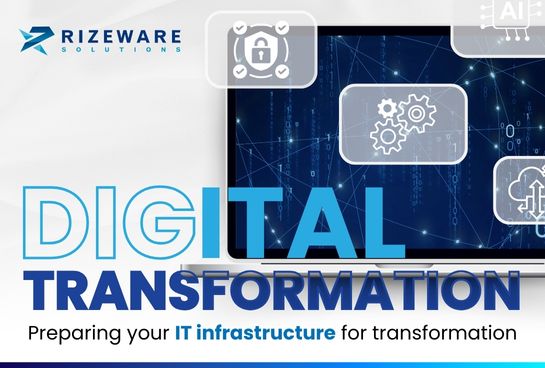
Preparing Your IT Infrastructure for Transformation

Erik Ruda
July 29 , 2024
Digital Transformation Blog Series – Erik Ruda, CEO, Rizeware Solutions
After you’ve spent sufficient time formulating your digital transformation vision and strategy and preparing for the changes that come with it, the next step is to ensure your IT infrastructure is optimized to support this transformation.
Every organization is unique and, therefore, will have different requirements when it comes to its IT infrastructure. However, every business would benefit from starting with a detailed assessment of its current IT investments. That means evaluating the cost, performance, and business value of all hardware, software, networks, and services deployed throughout the organization.
This assessment should not be based on the current state of your organization, though. Instead, focus on the IT infrastructure requirements needed to achieve the strategic objectives of your digital transformation journey. So, before beginning this assessment, be sure your leadership team is fully aligned on the specific business requirements that could impact the new IT architecture. For example, are there plans for additional office locations? How will business processes and workflows change? Will you need to connect differently with customers, partners, and suppliers?
Keep those issues in mind as you perform your assessment, and you will no doubt discover outdated technologies, performance bottlenecks, and gaps in your IT architecture. You will also discover opportunities to deploy new solutions that will resolve these issues and help accelerate business growth.
However–addressing complex IT issues will require time, people, and money, so once your assessment has been completed, plan on developing a detailed roadmap and timeline for your infrastructure transformation. This will enable you to prioritize changes, upgrades, and new investments that will deliver the greatest impact while minimizing disruption to the business.
Once the assessment and roadmap are completed, you’re ready to begin making the necessary changes to your infrastructure. But before you do, your business would benefit from appointing an IT architect as the overall project manager. Ideally, this person should have the skillset and experience connecting business requirements with IT investments and insight into emerging and disruptive technology trends.
Speaking of disruption, IDC Research recently published a report indicating that digital technologies and software-defined everything (SDx) will be disruptive (in a good way) over the next five years, enabling organizations to quickly take advantage of new business opportunities. IT teams involved in digital transformation initiatives will need to embrace new technologies to keep their organizations competitive and operating efficiently.
Let’s review a few of the key issues, technologies, and trends organizations must consider during the infrastructure transformation process.
Legacy Systems
- The first issue to resolve is what to do with legacy systems. Which ones still add value? Can they be upgraded to meet emerging business requirements? How well will they integrate with new technology investments? Leverage them if you can, but don’t let outdated systems slow the transformation process.
Data Migration
- Data is the lifeblood of every organization, so it must be managed very carefully throughout your transformation process. First, ensure all critical data is backed up and stored in a secure location. Then, determine which data will be essential moving forward. Carefully extract, transform, and load that data for use in your new systems and applications—whether they are deployed on-premises or in the cloud.
Network Connectivity
- Your business model and organizational structure (including the need to connect to customers, partners, and suppliers) will obviously influence your decisions about where and how much you want to upgrade network performance. In addition, the COVID pandemic has significantly increased the number of remote users and their use of cloud-hosted applications, so those trends will need to be considered as well.
Cloud Services
- In recent years, many organizations have migrated their on-premises data centers and business applications to the cloud to reduce costs, increase capacity, and expand access for employees and customers. In addition, businesses are increasingly leveraging cloud-hosted SaaS offerings from third-party vendors to support internal processes. Cloud services are really the cornerstone of a future-proof IT transformation strategy.
Security and Compliance
- Although these are separate issues, strong cybersecurity is often necessary to meet compliance requirements in certain industries. In addition, a distributed workforce accessing sensitive data hosted on one or more clouds makes endpoint devices attractive targets for cyberattacks. Consider adopting a zero-trust architecture as the foundation of your cyber strategy.
AI-powered Technologies
- We’ve already seen rapid advances in AI technology, and they’re only accelerating. Be sure to carefully evaluate the role of AI in your digital transformation strategy. It’s not perfect yet, but AI has already proven its value in automating tasks, improving operational efficiencies, saving money, and accelerating business growth.
Skills Talent Gap
- Lastly, it’s important to note that disruptive changes to an IT architecture—as well as the tools and technologies employees use—will inevitably require talent upgrades throughout the organization. Alternatively, your organization should develop a comprehensive plan to ensure that all employees are properly trained to extract the greatest business value from these IT investments.
There are a lot of moving parts in a strategic IT transformation project, so expect some surprises – good and bad. If your organization needs assistance in the planning, purchase, installation, and configuration of these complex technologies, be sure to tap into the expertise of firms like Rizeware Solutions.

